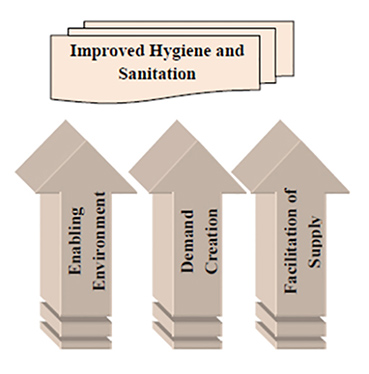5.1 The pillars on which the OWNP rests
Before explaining about the three pillars of the OWNP, we will revisit some points about the Ethiopian National Hygiene and Sanitation Strategy (NHSS) that you were introduced to in Study Session 2. The NHSS identified three strategic pillars to support the effort towards ensuring 100% coverage of improved hygiene and sanitation services across Ethiopia.
What were the three pillars of the NHSS?
They were: an enabling environment; sanitation and hygiene promotion, and improved access to hardware.
These pillars are described in more detail in the NHSS (MoH, 2005) and can be summarised as:
- Pillar 1: An enabling environment to support and facilitate an accelerated scaling-up [of sanitation and hygiene] through policy consensus, regulation, political commitment, inter-sectoral co-operation, partnership, capacity building, sustainable finance, research, monitoring and evaluation.
- Pillar 2: Sanitation and hygiene promotion to create demand and change behaviour using participatory approaches, advocacy, communication and social marketing.
- Pillar 3: Improved access to hardware to strengthen the provision of sanitation and hygiene through appropriate technology and product design for different situations (e.g. rural/urban, schools, health posts etc.).
The NHSS was followed in 2011 by the Strategic Action Plan (introduced in Study Session 2) which used the three pillars for its cover illustration in recognition of their importance (Figure 5.1).

Figure 5.1 depicts that the intended result of nationwide improved hygiene and sanitation can only happen if all three pillars are in place. If one of the pillars is neglected and efforts are inclined towards one or both of the others, it will ultimately end in failure. You can imagine this by its resemblance to house construction. It is common sense that, to build a durable house, you need strong pillars on which the whole structure will rest. The durability and reliability of the house is guaranteed not only by the strength of the pillars but also by their number. All the required number of pillars appropriate to the size of the house should be erected without any compromise, otherwise the house may not provide long service or may collapse immediately before it is finished.
This important principle of strong supporting pillars given balanced attention was adopted for the formulation of the OWNP. The original wording of the pillars of the NHSS gradually evolved and was improved and clarified to become the three pillars on which the OWNP is founded, shown in Box 5.1. You will notice these are very similar to the pillars of the National Hygiene and Sanitation Strategy, but the language has changed and the emphasis shifted in response to inputs from various stakeholders and developing priorities. Each of these pillars is described in detail in the following sections.
Box 5.1 The three pillars of the One WASH National Programme
- Creating an enabling environment and good governance.
- Maximising availability and efficient use of human and financial resources to create demand for better WASH services.
- Capacity development for improved delivery of WASH services at all levels.
(OWNP, 2013)
Learning Outcomes for Study Session 5
